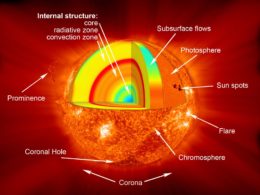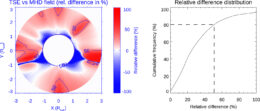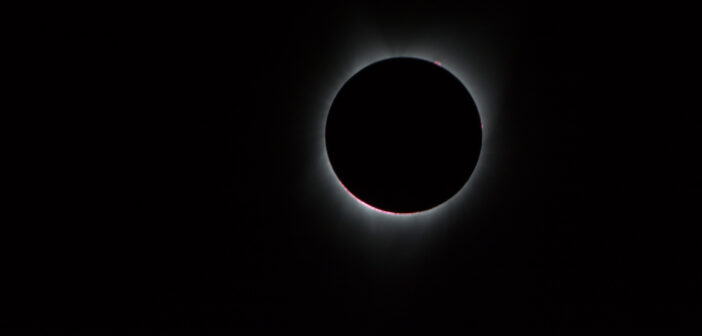A recent research article describes a new way to measure the magnetic field of the Sun’s tenuous upper atmosphere, or corona, from images taken during total solar eclipses.
Illuminating the Solar Corona

An illustration of the regions of the Sun’s atmosphere and interior. Click to enlarge. [NASA/Goddard]
Because direct measurements of the coronal magnetic field are hard to come by — the only spacecraft yet designed to travel into the harsh coronal environment, the Parker Solar Probe, has barely dipped a toe into the region — researchers must use complex models to reproduce measurements made from a distance to understand this important region of the Sun.

A projection of the magnetic field strength derived using the total solar eclipse (TSE) method and the magnetohydrodynamic (MHD) modeling method. Click to enlarge. [Bemporad 2023]
A Simpler Solution?
Alessandro Bemporad (National Institute for Astrophysics, Italy; Purple Mountain Observatory) explored a simpler way. Bemporad’s analysis method starts with polarized-light images of the corona from the 21 August 2017 total solar eclipse. The author first used an established technique to calibrate the images and convert the brightness of each pixel to an important physical quantity: how densely packed or rarefied the plasma is within the corona.
To convert from plasma density to magnetic field strength, Bemporad made a bit of a leap. In many physical systems, energy is distributed fairly equally among different types — like thermal, kinetic, magnetic, or potential energy. For a system like the solar corona, the dominant forms of energy are magnetic and gravitational potential. By making the assumption that these forms of energy are balanced, Bemporad estimated the magnetic field strength without needing complex modeling.
Looking Forward, Looking Back

Left: Relative difference between the magnetic field strength derived using the total solar eclipse method and the fluid modeling. Right: Cumulative distribution of relative differences between pixel values. Click to enlarge. [Bemporad 2023]
Bemporad notes that the new method can be applied to any white-light images of the solar corona, not just those taken during total solar eclipses. This means that any ground- or space-based images made using a coronagraph (an instrument that blocks the light from the Sun’s bright disk so that the fainter corona can be photographed) are ripe for further exploration, including images taken decades ago — opening a new window into the magnetic conditions of past solar cycles.
Citation
“Coronal Magnetic Fields Derived with Images Acquired during the 2017 August 21 Total Solar Eclipse,” A. Bemporad 2023 ApJ 946 14. doi:10.3847/1538-4357/acb8b8

